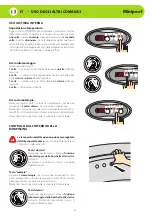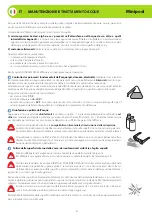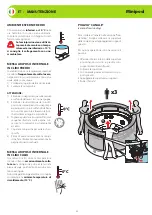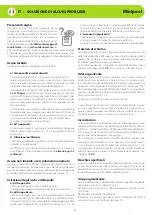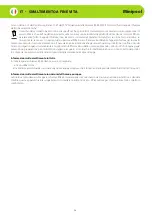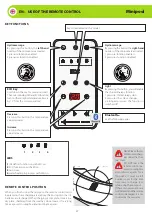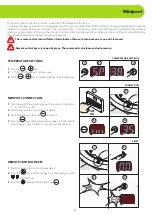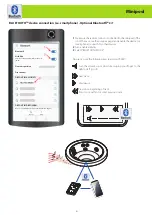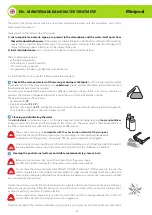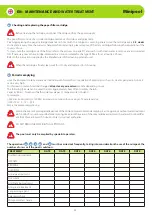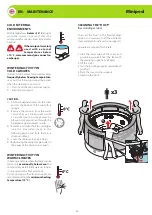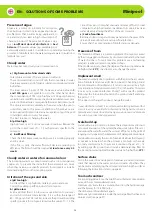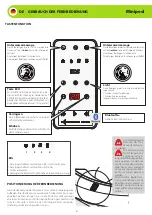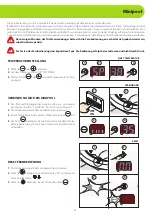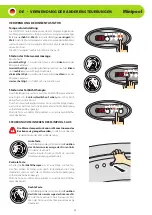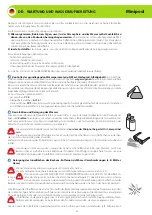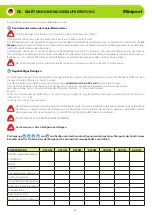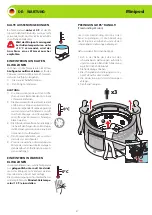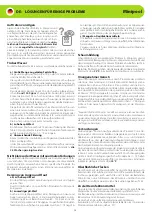
43
Minipool
En - MaInTEnancE anD
WATER TREATMENT
The water of the minipool must always be clean, clear and bacteriologically pure: this guarantees
users' safety
and a pleasant experience.
Contaminants in the water can be of two types:
1)
micro-organisms
,
bacteria, algae, etc. present in the atmosphere and the water itself, apart from
those introduced by the users.
If the water is not suitably filtered and disinfected, proliferation of these mainly
vegetal micro-organisms (algae) takes place. The results are green colouring of the water and the deposit of
slimy and slippery organic substances on the surface of the pool.
2)
inert solid substances:
dust, soil, hair, etc. brought by wind, rain and the bathers.
These contaminants increase:
- at the high temperatures,
- if the minipool is installed outdoors,
- if it is used by many people,
- if its parameters (hardness, pH, alkalinity) are unbalanced.
It is therefore VITAL to carry out the following operations regularly:
a
Check of the main parameters of the water (pH, hardness, alkalinity)
with test strips readily available
in specialized shops: if the three parameters are
unbalanced
, a larger quantity of additives and disinfectants (and
therefore maintenance) may be required.
For instance, excessively alkaline water makes it difficult to maintain the pH stable; in its turn, an unstable pH
promotes the formation of algae and therefore requires the use of more algicides than normal.
The optimal values are shown below:
- pH between
7-7.2
;
- alkalinity between
8-12.5°
F;
- hardness not exceeding
25°f
: it can be kept under control with the use of specific limescale sequestering agents
or by installing softeners on the water retrieval system.
B
Cleaning and disinfecting the water
Add
disinfectants
(i.e. bromine, oxygen ...) to the water capable of eliminating bacteria and
fungi and additives
to make it clearer (i.e. algicides, anti-foaming agents, flocculants, etc.). The water must be checked periodically to
see if the concentrations are sufficient to guarantee their effectiveness.
The products used must be
compatible with the construction material of the minipool
.
Over time, the use of different products may cause damages not recognized under warranty.
During the use of the products, always wear PPE (e.g. protective gloves and goggles).
Do not use the minipool until the level of disinfectants and additives is safe for bathing (refer to the labels).
Keep the whirlpool running to allow a more rapid distribution of the disinfectant or additive.
c
Cleaning the pool internal surfaces and visible contaminants (e.g. leaves, hair)
Before any maintenance, disconnect the minipool from the power supply.
For effective and safe cleaning, the minipool must be emptied (see page 22).
Do not leave the minipool empty and EXPOSED TO DIRECT SUNLIGHT. If left exposed to the sun, the
surface temperature of the minipool can exceed 80°C and get seriously damaged, with the surface and
components undergoing deformations and cavitation (any damages caused by direct exposure to sunlight
are not covered by the warranty).
To clean the surfaces, use soft cloths and neutral products suitable to the minipool materials: they are readily avail-
able in any specialized shop; follow the instructions for use found on the label of the product used.
Always finish
by drying it perfectly, possibly with chamois leather.
Avoid using abrasive, aggressive (e.g. solvents or acetone) or alcohol-containing detergents or cloths.
Do
not use limescale-removing products because too aggressive.
To restore the shine of the surfaces or eliminate resistant spots (e.g. nicotine), use car polish and some cotton wool.


